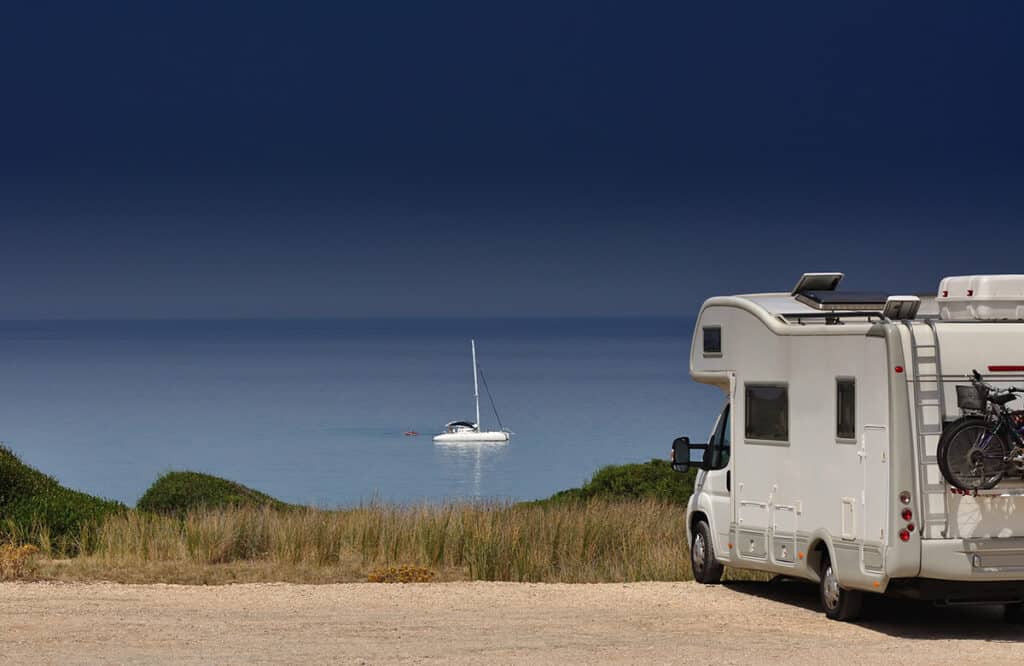“When will EES start?” “Do I need to apply for ETIAS before my next trip?” “Will these new systems ruin our European holiday?”
If these questions sound familiar, you’re not alone. My inbox has been flooded with messages from worried travellers trying to make sense of the EU’s upcoming border changes and wondering what they need to do.
Don’t worry- in this post we’ll share exactly what you need to know and do so you’re prepared the next time you visit Europe.
*We work hard to make this the best motorhome travel blog and road trip website possible, full of helpful content for you. The website is supported by our readers, so if you buy through links on this site we may earn a commission- at no extra cost to you. All opinions remain our own.
If you find this post useful, you can also treat us to a coffee – we promise to enjoy it while creating more useful content like this- we might even indulge in a biscuit (or two!)
The European Union has been planning two major changes to how non-EU travellers (including UK citizens) enter Europe. These are:
- the ETIAS visa system and
- the EES border system
It’s important to realise that these are two totally different systems, so although they’re often mentioned together, they are NOT the same thing. ETIAS is an online application to enter the EU done before you travel, while EES is something done AT the border.
Both systems have been ‘coming in soon’ for several years, but keep being pushed back, making it challenging to know what’s actually happening and when.
Let me break down everything you need to know about both systems, including the latest timeline updates, so you can plan your European adventures with confidence.
(Please note, this video was filmed in early 2025. New updates are shown below, but it does explain what EES and ETIAS are and how they will work.) Don’t forget to subscribe to our YouTube channel here
What Is EES?
EES stands for the Entry/Exit System. This is not something you apply for in advance. Instead, it’s a new method the EU will use to track entries and exits using biometric data.
When will EES start?
The European Union has announced that the long-awaited implementation of the Entry/Exit System (EES) is scheduled for October 2025. However, it’s anticipated that the system will not be introduced until November 2025 at Channel ports.
In March, the EU’s Home Affairs Minister announced that there would be a “progressive start of operations,” whereby the 29 countries of the Schengen Zone would gradually introduce the system over a period of six months.
Key Facts About EES:
- Replaces passport stamping: EES will replace the current system of manual stamping of passports
- Biometric data required: You’ll provide fingerprints and facial photos at the border
- First-time registration: When EES is introduced, you will need to create a digital record on your first visit to the Schengen area at the port or airport on arrival. This means you’ll provide your fingerprints and facial photos.
- Valid for 3 years: Once registered, you won’t need to repeat the full process for 3 years (unless you get a new passport)
- Tracks overstays: The system will automatically detect if someone exceeds the 90-day limit – you’ve been warned! Overstaying may stop you getting access into the EU in the future
What to Expect at the Border
On your first trip into the EU after EES launches:
- You’ll go to a self-service kiosk or booth
- Scan your passport
- Provide fingerprints
- Have your photo taken
- Answer basic questions about your visit
If you enter the Schengen area again during the following 3 years, you will only need to provide a fingerprint or photo at the border, when you enter and exit.
Expected Delays
Let’s face it, this is going to cause CHAOS.
Whether you’re entering the Schengen area by tunnel, boat or plane, every single person on that vehicle will need to complete these EES requirements. It’s expected to take about 1 minute per person, which means one coach will take about an hour, and an aircraft of 300 people could take several hours!
Specific Impact for Motorhomers: For vehicle crossings, each car entering the EU is expected to take 5–6 minutes longer for processing. Multiply that by hundreds of vehicles, and you can expect substantial delays, especially during peak travel periods and at busy crossing points such as Calais.
It should be noted that this isn’t an ‘anti-English’ scheme. The UK already has a system in place for non-residents who are entering the UK.
What Is ETIAS?
ETIAS stands for the European Travel Information and Authorisation System. Think of it like the ESTA system for travelling to the United States—it’s a travel authorisation you’ll need to apply for online before travelling into Europe/ the EU.
Can we just, for the sake of expediency, accept that I know that the UK is on the continent of Europe, but not inside ‘Europe’ for the purposes of this blog post? Thanks.
ETIAS will only become operational after EES has been running smoothly for at least 6 months. At the time of writing, it is expected to become operational in the last quarter of 2026, (although I really wouldn’t hold your breath until we see how EES does!)
Key Facts About ETIAS:
- It’s not a visa: It’s a travel authorisation, similar to what many other countries already require
- Valid for 3 years: Your ETIAS travel authorisation is valid for three years or until the travel document you used in your application expires – whichever comes first
- Multiple entries allowed: You can travel back and forth during the validity period
- Covers 30 countries: Austria, Belgium, Bulgaria, Croatia, Cyprus, Czech Republic, Denmark, Estonia, Finland, France, Germany, Greece, Hungary, Iceland, Italy, Latvia, Liechtenstein, Lithuania, Luxembourg, Malta, Netherlands, Norway, Poland, Portugal, Romania, Slovakia, Slovenia, Spain, Sweden, Switzerland
- Costs €7: Applying for the ETIAS travel authorisation costs EUR 7 for travellers aged 18–70. Under 18s and over 70s are exempt from paying this fee
- 90-day rule still applies: With a valid ETIAS travel authorisation, you can stay in the European countries requiring ETIAS for up to 90 days within any 180-day period. If you manage to get an extension to stay in one country for longer, you need to ensure your ETIAS authorisation matches this.
- Passport-linked: ETIAS is linked to your specific passport, so if you renew your passport, you’ll need a new ETIAS
Who Needs to Apply for ETIAS?
UK passport holders travelling to EU countries for:
- Tourism/ Road Trip adventures
- Business meetings/conferences
- Medical treatment
- Transit
You won’t need ETIAS for:
- Trips to the Republic of Ireland from the UK (Ireland is not in Schengen, and we have special arrangements between the UK & Ireland)
- Working or studying (you’ll need official visas for these)
- If you hold dual citizenship with an EU passport (you can use your EU passport instead)
How Will ETIAS Work?
ETIAS will be done online. You can fill out the application form using either the official ETIAS website europa.eu/etias or the ETIAS mobile application.
The application will ask for:
- Personal and passport details
- Travel plans (including the first EU country you’ll enter)
- Background questions about criminal history, health conditions, and immigration history
- Security, health, migration risk, and any past overstays or offences
Most applications are processed within minutes. However, it is possible that your application may take longer to process. If so, you will receive a decision within four days. In some cases requiring additional documentation or interviews, processing could take up to 30 days.
Important: There will be a transitional period of at least six months when ETIAS launches, meaning you should apply but won’t be refused entry if you don’t have one yet (as long as you meet other entry requirements). This will be followed by a 6-month grace period where travellers must have an ETIAS travel authorisation to enter, except for those coming to Europe for the first time since the end of the transitional period.
Preparing for the Changes- What you need to do
Current Trips: What You Need to Do Now
If you’re going on holiday into the EU/ Schengen Zone BEFORE October 2025, nothing changes. You don’t need to do anything.
- Continue travelling to Europe as you have been since Brexit
- No ETIAS application needed
- No biometric registration required
- Ensure your passport is valid for at least 6 months when travelling (you need 3 months clear from the date you leave
- Track your days in Europe to stay within the 90/180 rule
- Keep applying for AHCs as usual (although check out the anticipated Pet Passport rules)
From October 2025: EES Expected to Launch
- The European Union will inform us about the specific start date of the EES several months prior to its launch
- Be prepared for longer border crossing times
- You will not need to provide any information before travelling to a Schengen area country
- Consider allowing extra time for travel into the EU, or travelling during the night/ early morning to get the initial set up done and out the way as painlessly as possible.
Q4 2026: ETIAS Expected to Launch
- ETIAS is expected to become operational in the last quarter of 2026
- You’ll need to apply online before travelling
- The European Union will inform us about the start of ETIAS several months prior to its launch and when we need to start applying.
- Apply well in advance – don’t wait until the last minute, as processing could take up to 30 days if additional checks are needed
- Use only official websites: There is only one official ETIAS website: europa.eu/etias. Do not use third-party services which may charge excessive fees or steal your personal data
- Keep your confirmation: You’ll need your ETIAS authorisation number
- Check your passport validity: If you renew your passport, you’ll need a new ETIAS
- Don’t believe everything on Facebook – check official sources for accurate information
If you’d like to stay up to date will all info, and get a FREE Europe travel checklist, join our email list below:

Important Limitations and Considerations
I’ve seen a LOT of wrong information being spread about the EES and ETIAS schemes, so here are a few things to remember:
The 90-Day Rule Remains
Neither ETIAS nor EES changes the face that UK travellers can only spend 90 days in any 180-day period in the Schengen area. These systems will just make it easier for authorities to track compliance.
Ireland Is Different
Ireland is not part of Schengen and has separate arrangements with the UK. These new systems won’t affect UK-Ireland travel and nothing will change to what we do now.
Working and Studying
Having the travel authorisation only allows you to enter and remain on the territory of the European countries requiring ETIAS for a short-term stay. Also, it does not give you the right to study long-term or to work in these countries.
No Guarantee of Entry
Having a valid ETIAS travel authorisation does not automatically grant you the right to enter the territory of the European countries requiring ETIAS. All travellers arriving at the border are still subject to border checks.
Staying Updated
Given the multiple delays these systems have experienced, it’s important to get information from official sources:
Avoid unofficial websites that may charge excessive fees or collect your personal data inappropriately and DON’T trust everything you need on Facebook or Forums!
This information is based on official EU sources and current announcements as of July 2025. Always check the official ETIAS and EES websites for the most up-to-date information before travelling.
Bottom Line
Yes, it’s annoying. Yes, it’s going to cost a little more. Yes, queues might be worse for a time, but while these new systems add some complexity to European travel, they’re not insurmountable hurdles. Many other countries around the world already have similar requirements. The key is to stay informed about the timeline and be prepared when the systems launch.
For now, there’s no need to worry or change your current travel plans. Keep exploring Europe- just be ready to adjust to the new processes when the time comes!
New to motorhome or camper travel in Europe? You might find these posts helpful:
See all our Europe motorhoming posts here
NEED GEAR? If you need any kit or essentials for motorhoming in Europe, here’s what we recommend and where to find it






